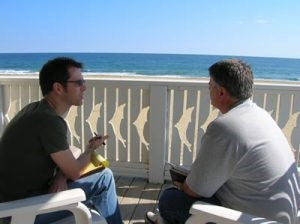
Coaching Intuition: What to Listen for When Coaching
Share
 Intuition is by definition an intuitive process, more art than science. But we can become more cognizant of what kinds of things cause us to sit up and take notice. A first step is to identify and name the common types of phenomena that activate our coaching intuition. The more we make intuition a conscious process, the more adept we will be at it.
Intuition is by definition an intuitive process, more art than science. But we can become more cognizant of what kinds of things cause us to sit up and take notice. A first step is to identify and name the common types of phenomena that activate our coaching intuition. The more we make intuition a conscious process, the more adept we will be at it.
Below are the five most important categories of intuition items I listen for when I’m coaching:
1. The Person’s Own Discernment or insight about the situation
2. Turning Points or key actions and events
3. Strong Emotion or reaction
4. Red Flags: things that don’t seem to fit or don’t sit right
5. Patterns: Cause and effect relationships or repeated outcomes in the client’s actions or thinking
These coaching intuition indicators are what most consistently point to meaning or significance in what’s being said.
The Indicators Defined
In coaching, the most common and important indicator is the person’s own discernment. The client is the person who has the most information about and responsibility for his or her own life. If God is going to speak to a person, He speaks “the firstest and the mostest” directly to that individual. That’s why we follow the client’s insight.
Turning points are significant moments or transitional events in a person’s life. A client may not be able to identify exactly how a transition affected their life, but they will often know something was different as a result of it. As a coach, that makes me curious—what happened there? Turning points can be important insights, victories, job changes, reverses, relocations, or they can be smaller: a conversation, a project or a decision can be a turning point. Look for any event that spawned a change of course.
A strong emotion indicates that our situation is affecting us deeply or touching on something important to us (we don’t get upset or overjoyed about something we don’t care about!). While many people discount their feelings, to a coach emotions contain information about what is going on inside.
Red flags are when the client’s statement doesn’t make sense, doesn’t seem to align with universal principles or simply strikes you wrong. Here’s an important principle about coaching intuition:
Intuition indicators don’t tell you there is a problem; they show you where to ask.
Patterns are cause and effect relationships or repeating events in the client’s life. You reap what you sow—and if you keep right on sowing, you’ll keep right on reaping! Patterns can also show up over multiple coaching appointments. If there is a pattern, there is a reason behind it. People have a good reason for what they do. Discover the reason and usually you’ve also found the key to changing the pattern.
Tony Stoltzfus is a best-selling author, leadership coach, master coach trainer and director of the Leadership Metaformation Institute. Additional information on the role of listening in the coaching relationship can be found in Tony’s book, Leadership Coaching.
